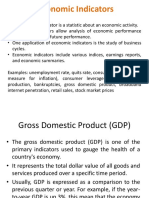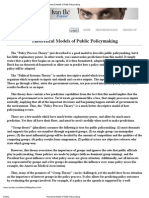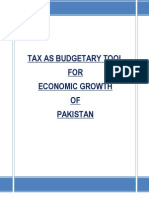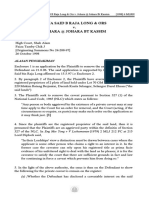0 ratings0% found this document useful (0 votes)
363 viewsFiscal Policy
Fiscal Policy
Uploaded by
Anum ImranFiscal policy involves a government's tax revenue collection and spending activities to influence macroeconomic stability. It aims to control inflation, employment levels, income distribution, and economic growth. Fiscal policy tools include tax rates and types as well as government expenditure. Expansionary fiscal policy stimulates the economy through spending increases or tax cuts, while contractionary policy restrains the economy through spending cuts or tax hikes. Deficit financing, when a government borrows to cover budget shortfalls, can impact inflation, interest rates, and private investment. The document discusses Pakistan's fiscal challenges and reforms to generate more revenue and reduce its budget deficit.
Copyright:
© All Rights Reserved
Available Formats
Download as PPTX, PDF, TXT or read online from Scribd
Fiscal Policy
Fiscal Policy
Uploaded by
Anum Imran0 ratings0% found this document useful (0 votes)
363 views49 pagesFiscal policy involves a government's tax revenue collection and spending activities to influence macroeconomic stability. It aims to control inflation, employment levels, income distribution, and economic growth. Fiscal policy tools include tax rates and types as well as government expenditure. Expansionary fiscal policy stimulates the economy through spending increases or tax cuts, while contractionary policy restrains the economy through spending cuts or tax hikes. Deficit financing, when a government borrows to cover budget shortfalls, can impact inflation, interest rates, and private investment. The document discusses Pakistan's fiscal challenges and reforms to generate more revenue and reduce its budget deficit.
Original Description:
fiscal policy of pakistan
Copyright
© © All Rights Reserved
Available Formats
PPTX, PDF, TXT or read online from Scribd
Share this document
Did you find this document useful?
Is this content inappropriate?
Fiscal policy involves a government's tax revenue collection and spending activities to influence macroeconomic stability. It aims to control inflation, employment levels, income distribution, and economic growth. Fiscal policy tools include tax rates and types as well as government expenditure. Expansionary fiscal policy stimulates the economy through spending increases or tax cuts, while contractionary policy restrains the economy through spending cuts or tax hikes. Deficit financing, when a government borrows to cover budget shortfalls, can impact inflation, interest rates, and private investment. The document discusses Pakistan's fiscal challenges and reforms to generate more revenue and reduce its budget deficit.
Copyright:
© All Rights Reserved
Available Formats
Download as PPTX, PDF, TXT or read online from Scribd
Download as pptx, pdf, or txt
0 ratings0% found this document useful (0 votes)
363 views49 pagesFiscal Policy
Fiscal Policy
Uploaded by
Anum ImranFiscal policy involves a government's tax revenue collection and spending activities to influence macroeconomic stability. It aims to control inflation, employment levels, income distribution, and economic growth. Fiscal policy tools include tax rates and types as well as government expenditure. Expansionary fiscal policy stimulates the economy through spending increases or tax cuts, while contractionary policy restrains the economy through spending cuts or tax hikes. Deficit financing, when a government borrows to cover budget shortfalls, can impact inflation, interest rates, and private investment. The document discusses Pakistan's fiscal challenges and reforms to generate more revenue and reduce its budget deficit.
Copyright:
© All Rights Reserved
Available Formats
Download as PPTX, PDF, TXT or read online from Scribd
Download as pptx, pdf, or txt
You are on page 1of 49
FISCAL POLICY
Presented by: Ayesha Abdul Wahid
Haseeb Nagaria
shahroze Arshad
Rahima Tanseer
Samuelson , Fiscal Policy is concerned with all those
arrangements which are adopted by the Government
to collect the revenue and make the expenditures so
that economic stability could be attained/maintained
without inflation and deflation.
According to Lipsey: Govt. revenue raising and
Govt. revenue spending activities are called Fiscal
policy.
According to M.W.Lee: Fiscal policy considers (i)
imposition of taxes, (ii) Govt. expenditures. (iii)
Public debt and (iv) Management of public debt.
Controlling the level of
employment
Controlling inflation
Achieving the desirable level of
income distribution
Controlling the level of
consumption in the economy
Proper utilization of economic resources
Increasing foreign exchange reserves
Reducing burden of foreign debts
Control on concentration of wealth
Promoting trade and industrial development
Expansionary fiscal policy
Expansionary fiscal policy is designed to stimulate the
economy during or anticipation of a business-cycle
contraction.
This is accomplished by increasing aggregate
expenditures and aggregate demand through an increase
in government spending (both government purchases
and transfer payments) or a decrease in taxes.
Expansionary fiscal policy leads to a larger government
budget deficit or a smaller budget surplus.
Contractionary fiscal policy
Contractionary fiscal policy is designed to restrain
the economy during or anticipation of an inflation-
inducing business-cycle expansion.
This is accomplished by decreasing aggregate
expenditures and aggregate demand through a
decrease in government spending (both government
purchases and transfer payments) or an increase in
taxes.
Contractionary fiscal policy leads to a smaller
government budget deficit or a larger budget
surplus.
Integrated Energy
Modernization of Infrastructure
Indigenous Resource Mobilization
Institutional Reforms and Governance
Value-addition in Commodity Producing
Sectors
Export promotion and Private Sector Led
Growth
Social Capital
Private sector as an engine of growth
An efficient professional and accountable
public sector
Corporate governance based on OECD
guidelines
Macroeconomic stability with inclusive growth
Political stability and peaceful Pakistan.
To have good quality of life and high living
standards compatible with emerging
economies like Malaysia.
To achieve an annual growth rate of 7 to 8
percent by 2025.
To bring about structural transformation of
economy from low productivity to high
productivity in all real sectors.
To build institutions and social capital
commensurate with requirements of high
growth economy.
To have energy, food and water security.
To put private sector as driver of growth and
ensuring enabling through better public
management and good corporate governance.
TOOLS OF FI SCAL POLI CY
1- REVENUE
Example TAXES
2- EXPENSES
Example
GOVERNMENT
EXPENDITURE
SOURCES OF
REVENUES
SOURCES OF
EXPENDITURE
Tax Revenues
Non-tax Revenues
Current
Interest
Pension
Grants
Defense
Public order & safety
Development
Federal
Provincial
Other development
& net lending
Fee levied by the government on product,
income or activity.
Purpose of Tax
To finance government expenditure as well as
public goods and services.
Difference between potential and actual tax
collection.
Causes of Tax Evasion
Weak system
Consequences of Tax Evasion
Dependency on IMF and other donors.
Unjust tax system.
Indirect taxes have been increased.
Regressive Taxation
Performance on Tax collection
Rs.2.7 trillion estimated
Shortfall in last Quarter
was 70 billion
Tax collection comparison
(34%)
Current Issues
Three measure are being pondered:
- Equal to shortfall in revenue, or
- Withdrawal of tax exemptions or
- Cut in development expenditures.
Government woes to push budget deficit to 6.3%.
Tax to GDP ratio 8.8%
Narrow Tax base
Massive Tax Evasion
Administrative Weaknesses
Some sectors under Taxed, Some not taxed at all.
Agriculture
Services
Regressive taxation rather than progressive
Tax buoyancy is an indicator to measure
efficiency and responsiveness of revenue
mobilization in response to growth in the Gross
domestic product or National income.
A tax is said to be buoyant if the tax revenues
increase more than proportionately in response
to a rise in national income or output.
Usually, tax elasticity is considered a better
indicator to measure tax responsiveness
Deficit financing refers to the
borrowing undertaken by the
government to make up for the
revenue shortfall.
Rise in government expenditures
No rule based fiscal policy
Low savings
Rapid population growth
1) Bank borrowing
- The SBP issues new currency notes in the
amount being lend to the Government .
-The Government draws upon the cash
balances of the past for fulfilling the budget
deficit.
The effect of deficit financing through bank
borrowing is that it increases money supply
in the economy and creates inflationary
pressure
2) Non-bank borrowing - Domestic Borrowing.
funds to bridge the deficits in the budget are
mobilized through the T-Bills, Short Term
Federal Bonds, etc
This increases domestic interest rates, and
discourages private investment in the nation
3) External borrowing
The consistent large fiscal deficits have forced
the government of Pakistan to borrow from
foreign lenders
This has a negative effect on exchange rate
around 40 percent of the addition in public debt originated
from PKR depreciation, which inflated the external debt
during Q1-FY14. More specifically, Rupee depreciation
against US Dollar resulted in Rs 348.3 billion increase in the
Rupee value of external debt
As regards the domestic debt, the increase came primarily
from budgetary borrowings from SBP to finance the fiscal
gap. However, it should be noted that the increase in
domestic debt far exceeded actual budgetary requirements
during the quarter; financing of the government from
domestic sources was Rs 314.1 billion,25 but domestic debt
shows an increase of Rs 634.0 billion during the quarter. This
difference arose mainly because the government borrowed
more funds than it actually required, and placed the
additional funds in its deposits held by SBP
(1) It mobilizes additional resources for
economic development.
(2) It helps in utilization of unutilized and
under-utilized resources of the country.
(3) It helps in building up social and economic
overheads.
(4) It helps in ensuring higher level of
employment in the country by productive use
of resources.
1) interest rate increases which hinders
private investment
When the government borrows funds, it
competes with the private business for
attaining funds. The additional demand for
funds raises interest rate in the money market.
2) In case the deficit financing is financed by
printing of money by SBP, It
creates inflationary impact on the economy,
which
(a) discourages foreign investment
(b) Reduces exports
(c) Increases imports
(d) Increases inequality in the distribution of
income
(e) Lowers saving rate in the economy and
(f) Encourages wasteful expenditures.
Introduction
Numerous Challenges both external and internal
Importance of Prudent Fiscal Policy
Fiscal Performance of the Country improved
between 2003-2007
Deterioration of Fiscal Performance after 2007
Slowdown in Growth
Fiscal Deficit widened to 8% on account of over
estimation of Budgeted Tax Revenue,
underestimation of subsidies and Interest
Payments and settlement of Circular Debt.
Revenue increased by 16.2%.Tax Revenue
showed a significant slowdown due to
1. Reducing FED rate on Sugar from 8% to 0.5%
2. Reduction in sales tax rate on electricity for
steel melters etc
3. Duty Reduction on Imports
4. Lowering of Withholding tax
Expenditures increased by 22.4% compared to
14.2 % increase in FY12
Debt Servicing accounts for quarter of total
expenditures.
Subsidies are the second largest expenditure.
PSDP was cut down below its budgeted target
to limit the fiscal deficit
Goal
1. Price Stability
2. Switching over to targeted subsidies
3. Generating more Revnues
Taxing all the sectors of the economy and
limiting or eliminating exemptions
Restoring wealth tax
Overcoming the problem of under invoicing of
imports
Tax Administrative reforms
Fiscal Deficit remained at 3.2% as compared to
4.7% last year during the same period
Ensuring Fiscal Sustainability by phasing out of
electricity subsidies,restructuring/privatization
of PSE and raising revenue
Reforms in PSE
Restructuring Plan for Pakistan Steel Mill
Bail out Package for PIA
Grant for Pakistan Railway
Privatization of 31 PSEs
Fiscal Deficit expected to reduce to 6%
Tax Reforms
Enhancing resource mobilization and
increasing tax to gdp ratio
Broadening the tax Base
Administrative Improvement Initiatives
Tax Payers Facilitation
Strengthening Tax Audit
Total Expenditure expected to reduce to 20.4%
of GDP
Table 4.3: Trends in Components of
Expenditure
Year Total Current Interest
Defenc
e
Developme
nt
Non
Interest
Expenditure
Expenditur
e
Payment
s (D)
Expenditur
e
Non-
Defence
(A) (B) (C)
(E) Exp
(A-C-D)
2005-06 17.1 12.6 2.9 2.9 4.4 11.2
2006-07 19.5 14.9 4.0 2.7 4.7 12.8
2007-08 21.4 17.4 4.6 2.6 4.2 14.2
2008-09 19.2 15.5 4.8 2.5 3.6 11.8
2009-10 20.2 16.0 4.3 2.5 4.1 13.4
2010-11 18.9 15.9 3.8 2.5 2.8 12.6
2011-12 19.6 15.6 4.4 2.5 3.7 12.7
2012-13 21.4 16.3 4.4 2.4 3.5 14.6
2013-
14B 20.4 15.2 4.4 2.4 5.1 13.5
2013-14 July-March Growth
B.E 2013-14 2012-13
A. Total Revenue 3,646.7 2,477.4 2,124.9 16.6
a) Tax Revenue 2,768.1 1,786.2 1,527.8 16.9
Federal 2,598.1 1,650.0 1,418.3 16.3
of which FBR Revenues 2,475.0 1,574.8 1,335.2 17.9
Provincial Tax Revenue 170.0 136.2 109.6 24.3
b) Non-Tax Revenue 878.6 691.2 597.0 15.8
B. Total Expenditure 5,297.2 3,289.0 3,171.1 3.7
a) Current Expenditure 3,963.0 2,904.6 2,642.0 9.9
Federal 2,778.0 2,083.2 1,887.1 10.4
- Interest 1,153.5 909.1 772.2 17.7
- Defense 627.2 451.7 405.8 11.3
Provincial 1,185.0 821.4 754.9 8.8
b) Development Expenditure & net
lending 1,334.3 555.8 445.8 24.7
PSDP 1,155.0 393.0 407.4 -3.5
Other Development 171.8 77.0 37.3 106.6
c) Net Lending 7.5 85.9 1.1 -
e) Statistical discrepancy - -171.3* 83.3 -
C. Overall Fiscal Deficit 1,650.6 811.7 1,046.2 -22.4
As % of GDP 6.3 3.2 4.7 -
Financing of Fiscal Deficit 1,650.6 811.7 1,046.2 -22.4
i) External Sources 168.7 -50.1 -4.1 -
ii) Domestic 1,481.8 861.7 1,050.3 -18.0
- Bank 975.0 436.9 856.7 -49.0
- Non-Bank 506.8 424.8 193.7 119.4
GDP at Market Prices 26,001 25,402 22,489 13.0
Source: Budget Wing, Finance
Division
Non tax revenue also includes Universal
Support Fund and the Coalition Support Fund
Total Expenditures registered a decline in the
second and the third quarters
Subsidies remained lower than the previous
period
Ceasing Secret service expenditures of all Ministries /Divisions/ Attached
Departments /Autonomous Bodies except Intelligence Agencies.
Discontinuation of Discretionary funds for Prime Minister and Ministers.
Allocation of PMs House/ PM Office reduced voluntarily by 40 percent. Moreover,
30 percent cut in current budget of Ministries/Divisions, except pay and allowances,
resulted in saving of billion rupees.
Working of foreign missions reviewed and being rightsized leading to expected
savings of Rs 2 billion annually.
Cabinet Committee on Restructuring has directed all Ministries / Divisions to review
for rationalizing their strengths for the purpose of rightsizing.
Fee/remuneration for government nominated directors in PSEs capped at Rs 600,000/ per annum.
Amount over and above will be deposited into government treasury
You might also like
- PWD Constitution and By-LawsDocument6 pagesPWD Constitution and By-LawsMa. Gelina E. Depone86% (21)
- CPBRD Policy Brief No. 2012-06 - Review of The Philippine Crop InsuranceDocument16 pagesCPBRD Policy Brief No. 2012-06 - Review of The Philippine Crop InsuranceKarloAdrianoNo ratings yet
- Chapter Introduction:: Advantages of BudgetDocument10 pagesChapter Introduction:: Advantages of BudgetreneeshrameshNo ratings yet
- Zambia Decentralisation PolicyDocument35 pagesZambia Decentralisation PolicyMaugahn Muff-Wheeler100% (1)
- Fiscal Policy - The Basics: A) IntroductionDocument7 pagesFiscal Policy - The Basics: A) IntroductionmalcewanNo ratings yet
- Contractor Accomplishment Report Form 010219Document1 pageContractor Accomplishment Report Form 010219John Rheynor MayoNo ratings yet
- Fiscal PolicyDocument24 pagesFiscal Policyરહીમ હુદ્દાNo ratings yet
- Fiscal PolicyDocument23 pagesFiscal PolicySunaina KhoslaNo ratings yet
- Fiscal PolicyDocument29 pagesFiscal Policyjay100% (1)
- Tied To The Mast: Fiscal Rules and Their Uses: The Peterson-Pew Commission On Budget ReformDocument27 pagesTied To The Mast: Fiscal Rules and Their Uses: The Peterson-Pew Commission On Budget ReformCommittee For a Responsible Federal BudgetNo ratings yet
- Government Budget 2021Document21 pagesGovernment Budget 2021Sireen IqbalNo ratings yet
- Public Finance and Fiscal PolicyDocument51 pagesPublic Finance and Fiscal PolicyWASSWA ALEXNo ratings yet
- Performance Based Budgeting: Some ViewsDocument4 pagesPerformance Based Budgeting: Some ViewsadityatnnlsNo ratings yet
- Factors Affecting Economic Development PDFDocument2 pagesFactors Affecting Economic Development PDFTara0% (2)
- Responsibility of Fiscal Policy UPDATEDDocument24 pagesResponsibility of Fiscal Policy UPDATEDFiona RamiNo ratings yet
- Business EconomicsDocument6 pagesBusiness EconomicsAnkush BhoriaNo ratings yet
- Short Notes On Public FinanceDocument3 pagesShort Notes On Public FinanceJakir_bnkNo ratings yet
- Inflation in Cambodia-Causes and Effects On The PoorDocument3 pagesInflation in Cambodia-Causes and Effects On The PoorVutha Ros100% (1)
- Zero Based BudgetingDocument2 pagesZero Based BudgetingVincentcius Pratama WahyuNo ratings yet
- Fiscal FunctionsDocument3 pagesFiscal FunctionsAshashwatmeNo ratings yet
- The Structural Adjustment Program in Nigeria0007Document9 pagesThe Structural Adjustment Program in Nigeria0007kymhanNo ratings yet
- Fiscal PolicyDocument5 pagesFiscal PolicyAmnaAnwar100% (1)
- Theory On Public ExpenditureDocument33 pagesTheory On Public ExpenditureDrRam Singh KambojNo ratings yet
- Public FinanceDocument2 pagesPublic Financemohamed sheikh yuusuf100% (1)
- 4 Major Sectors of An Economy: 1. Household SectorDocument3 pages4 Major Sectors of An Economy: 1. Household SectorMartha EeluNo ratings yet
- Budget and BudgetryDocument6 pagesBudget and Budgetryram sagar100% (1)
- Fiscal PolicyDocument28 pagesFiscal PolicyDhawal RajNo ratings yet
- Accounting TheoryDocument7 pagesAccounting TheoryRochmatullah100% (1)
- Macroeconomics AssignmentsDocument15 pagesMacroeconomics Assignmentsapi-3712367No ratings yet
- Ways of Curbing InflationDocument3 pagesWays of Curbing InflationPooja EkkaNo ratings yet
- Methods of BudgetingDocument30 pagesMethods of BudgetingShinjiNo ratings yet
- Chapter-One Overview of Public Finance & TaxationDocument211 pagesChapter-One Overview of Public Finance & Taxationarsen lupinNo ratings yet
- Aggregate Demand in The Closed Economy: 2.1. Introduction: Income-Expenditure Approach Some Important IdentitiesDocument26 pagesAggregate Demand in The Closed Economy: 2.1. Introduction: Income-Expenditure Approach Some Important IdentitiesProveedor Iptv EspañaNo ratings yet
- Final 2020 Mid-Year Fiscal Policy Review - Ken Ofori-AttaDocument44 pagesFinal 2020 Mid-Year Fiscal Policy Review - Ken Ofori-AttaKweku Zurek100% (1)
- DBM Budget CycleDocument1 pageDBM Budget CycleReyner Delos Reyes Valencia100% (1)
- Specific Factors and Income Distribution: Eleventh Edition, Global EditionDocument69 pagesSpecific Factors and Income Distribution: Eleventh Edition, Global EditionBilge SavaşNo ratings yet
- Term Paper On Remittance and Its Impact On Nepalese Economy: Prof. Dr. Ram Prasad Gyanwaly MacroeconomicsDocument12 pagesTerm Paper On Remittance and Its Impact On Nepalese Economy: Prof. Dr. Ram Prasad Gyanwaly MacroeconomicsAshmita LamsalNo ratings yet
- The Budget Cycle: Government AccountingDocument42 pagesThe Budget Cycle: Government AccountingAllen GonzagaNo ratings yet
- Lecture 3Document14 pagesLecture 3skye080No ratings yet
- Fiscal AdministrationDocument5 pagesFiscal AdministrationMercy GolipapaNo ratings yet
- Final Exam: Part I (30 Points) - Multiple Choice QuestionsDocument11 pagesFinal Exam: Part I (30 Points) - Multiple Choice QuestionsStefaniaGiansiracusaNo ratings yet
- Management Art or ScienceDocument9 pagesManagement Art or ScienceMallidi Charishma ReddyNo ratings yet
- Economic IndicatorsDocument10 pagesEconomic Indicatorss.r.100% (1)
- Keynesian TheoryDocument98 pagesKeynesian Theorysamrulezzz100% (1)
- Theoretical Models of Public PolicymakingDocument3 pagesTheoretical Models of Public Policymakingmaheshkrishna1100% (1)
- Introduction To Econometrics For FinanceDocument93 pagesIntroduction To Econometrics For FinanceAshenafi Zeleke100% (1)
- What Is CAPACITYDocument5 pagesWhat Is CAPACITYDandanies DoNo ratings yet
- Assignment On Budget 2016-17Document34 pagesAssignment On Budget 2016-17tanmri75% (8)
- 9 Interest Rates, 10.28.21Document12 pages9 Interest Rates, 10.28.21Rochelle Anne OpinaldoNo ratings yet
- The Four Dimensions of Public Financial ManagementDocument9 pagesThe Four Dimensions of Public Financial ManagementInternational Consortium on Governmental Financial Management100% (2)
- Eco 441 Economic Planning IDocument117 pagesEco 441 Economic Planning IAdeniyi Adedolapo OLanrewajuNo ratings yet
- Understanding Public Policy PDFDocument5 pagesUnderstanding Public Policy PDFBrandon McintoshNo ratings yet
- Guidelines On Provincial/Local Planning and Expenditure Management Volume 4Document148 pagesGuidelines On Provincial/Local Planning and Expenditure Management Volume 4Carl100% (1)
- Market-Based Transfer Prices 2. Cost-Based Transfer Prices 3. Negotiated Transfer PricesDocument10 pagesMarket-Based Transfer Prices 2. Cost-Based Transfer Prices 3. Negotiated Transfer PricesvmktptNo ratings yet
- Types of BudgetDocument6 pagesTypes of BudgetadityatnnlsNo ratings yet
- Taxation in PakistanDocument22 pagesTaxation in PakistanAdnan AkramNo ratings yet
- Is Fiscal Policy the Answer?: A Developing Country PerspectiveFrom EverandIs Fiscal Policy the Answer?: A Developing Country PerspectiveNo ratings yet
- Fiscal Policies of Developing EconomiesDocument25 pagesFiscal Policies of Developing EconomieskapilbabbarNo ratings yet
- Presentation On Fiscal Policy of India: Submitted To:-Mrs. Anuradha MittalDocument19 pagesPresentation On Fiscal Policy of India: Submitted To:-Mrs. Anuradha MittalpreetsinghjjjNo ratings yet
- Factors Effecting Fiscal PolicyDocument24 pagesFactors Effecting Fiscal PolicyFaizan Sheikh100% (2)
- Unit 9: It Shows The Shortfall of Government's Current Receipts Over Current ExpenditureDocument9 pagesUnit 9: It Shows The Shortfall of Government's Current Receipts Over Current ExpenditureShaikh ShanuNo ratings yet
- PakLivestock Hamid Yaqoob SheikhDocument52 pagesPakLivestock Hamid Yaqoob SheikhAnum ImranNo ratings yet
- Dalda PresDocument39 pagesDalda PresAnum Imran0% (1)
- Topic Subject Submitted To:: Accounts Receivable Management: Introduction To Business Finance: Mr. Kamran RabbaniDocument4 pagesTopic Subject Submitted To:: Accounts Receivable Management: Introduction To Business Finance: Mr. Kamran RabbaniAnum ImranNo ratings yet
- DALDA AR QuestionaireDocument8 pagesDALDA AR QuestionaireAnum ImranNo ratings yet
- Accounts Receivable DALDADocument29 pagesAccounts Receivable DALDAAnum ImranNo ratings yet
- Strategy and Competitive Advantage in Diversified CompaniesDocument61 pagesStrategy and Competitive Advantage in Diversified CompaniesAnum ImranNo ratings yet
- Statutory ConceptsDocument1 pageStatutory ConceptsMyrr TeoNo ratings yet
- Payslip 09may2023Document1 pagePayslip 09may2023Thi MaiNo ratings yet
- Resume TN Hj. SadeDocument2 pagesResume TN Hj. SadeZulkhairiNo ratings yet
- Jan L. Chapman v. Roscoe L. Egger, Jr. and Donald L. Breihan, 813 F.2d 400, 4th Cir. (1986)Document2 pagesJan L. Chapman v. Roscoe L. Egger, Jr. and Donald L. Breihan, 813 F.2d 400, 4th Cir. (1986)Scribd Government DocsNo ratings yet
- Citizen's Charters: An Empirical Study: - by H.P.Shiva ShankarDocument13 pagesCitizen's Charters: An Empirical Study: - by H.P.Shiva ShankarRohit MalpaniNo ratings yet
- Consti 1 2020-2021 Syllabus PDFDocument21 pagesConsti 1 2020-2021 Syllabus PDFManuelMarasiganMismanosNo ratings yet
- Stop Advertising Victims of Exploitation (SAVE) ActDocument19 pagesStop Advertising Victims of Exploitation (SAVE) ActkirkilsenNo ratings yet
- Coliseum Commission Meetings/Records DecisionDocument16 pagesColiseum Commission Meetings/Records DecisionTerry FranckeNo ratings yet
- AP/HUMA 1770 6.0A One World: Historical and Cultural Perspectives of GlobalizationDocument33 pagesAP/HUMA 1770 6.0A One World: Historical and Cultural Perspectives of GlobalizationElric KuNo ratings yet
- 0000111Document277 pages0000111maildhavalmail100% (1)
- Show 2Document2 pagesShow 2Lexi BrownNo ratings yet
- PRC Oath FormDocument2 pagesPRC Oath FormCalvin TanNo ratings yet
- Jayantilal H. Patel Law College Intra-Collegiate Moot Court Competition 2019Document25 pagesJayantilal H. Patel Law College Intra-Collegiate Moot Court Competition 2019Krina BhavsarNo ratings yet
- The Hon'Ble Supreme Court of India: BeforeDocument17 pagesThe Hon'Ble Supreme Court of India: BeforeNandini SrivastavaNo ratings yet
- Connecticut Mandatory Disclosure of Real Estate Agency RelationshipsDocument6 pagesConnecticut Mandatory Disclosure of Real Estate Agency RelationshipsRobert OramNo ratings yet
- Geluz vs. CADocument2 pagesGeluz vs. CAIraNo ratings yet
- Malolos RepublicDocument33 pagesMalolos RepublicYuste, Angelica Heart L.No ratings yet
- Magna Carta and Code of EthicsDocument28 pagesMagna Carta and Code of EthicsJaecin GeilNo ratings yet
- Franchising and The Entrepreneur: © 2009 Pearson Education, Inc. Publishing As Prentice Hall 1 Chapter 4 FranchisingDocument34 pagesFranchising and The Entrepreneur: © 2009 Pearson Education, Inc. Publishing As Prentice Hall 1 Chapter 4 FranchisingBibhu R. TuladharNo ratings yet
- Raja Said (Defective)Document7 pagesRaja Said (Defective)Joey WongNo ratings yet
- De Guia Vs Manila Electric Railroad & Light CompanyDocument5 pagesDe Guia Vs Manila Electric Railroad & Light CompanyJune Vincent Ferrer100% (1)
- Volume IDocument363 pagesVolume IMuhammad Usman HayatNo ratings yet
- Century Old Legal System: Whether Change Necessary or Not: Topics of The AssignmentDocument17 pagesCentury Old Legal System: Whether Change Necessary or Not: Topics of The AssignmentCharming MakaveliNo ratings yet
- Nikhil Parthsarthi, Batch XIV,, Sem 5, Labour Law 2Document16 pagesNikhil Parthsarthi, Batch XIV,, Sem 5, Labour Law 224. Rashi -Kaveri-KavilashNo ratings yet
- Nature of Public Law and Its Imortance in GovernanceDocument13 pagesNature of Public Law and Its Imortance in GovernanceAsweta M100% (5)
- Question I - Explain Some of The Hurdles Litigants Have Encountered When It Comes To The EndangeredDocument3 pagesQuestion I - Explain Some of The Hurdles Litigants Have Encountered When It Comes To The EndangeredpoojaNo ratings yet
- Budgeted Lesson in Philippine Politics and Governance: Natividad National High SchoolDocument5 pagesBudgeted Lesson in Philippine Politics and Governance: Natividad National High SchoolJonalyn BanezNo ratings yet
- CN 22 EpDocument33 pagesCN 22 EpScribdNo ratings yet































































































